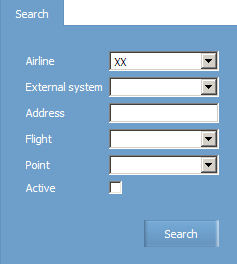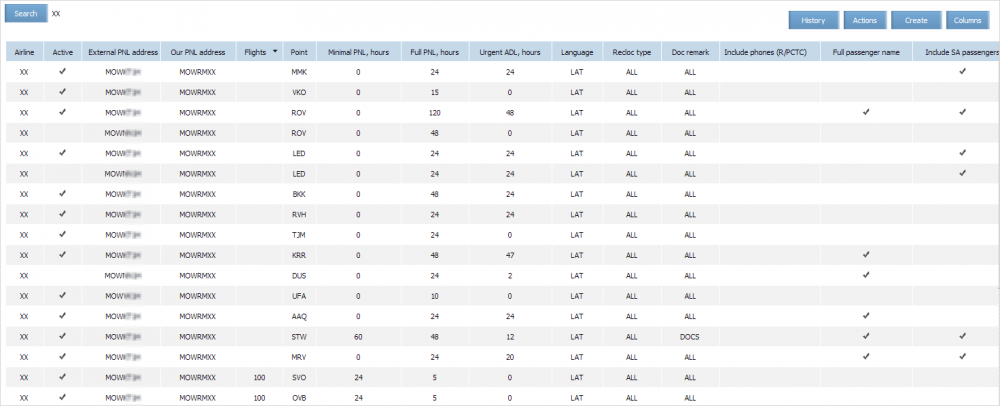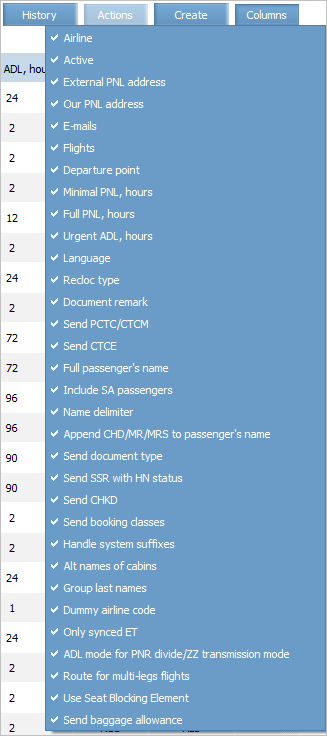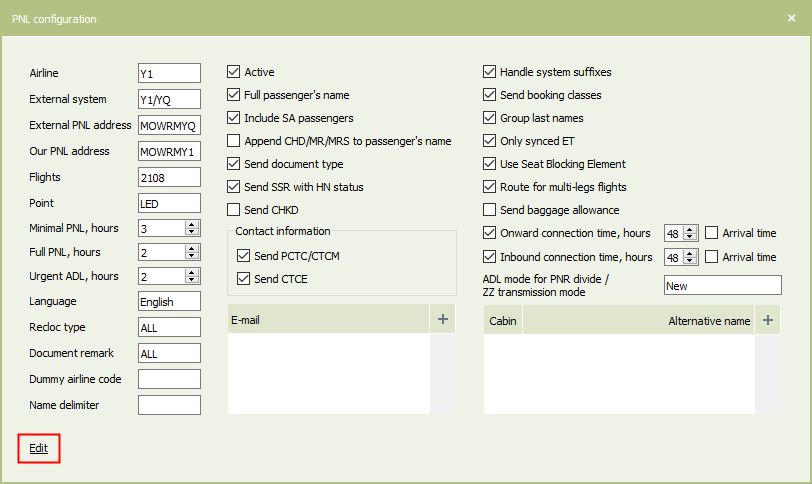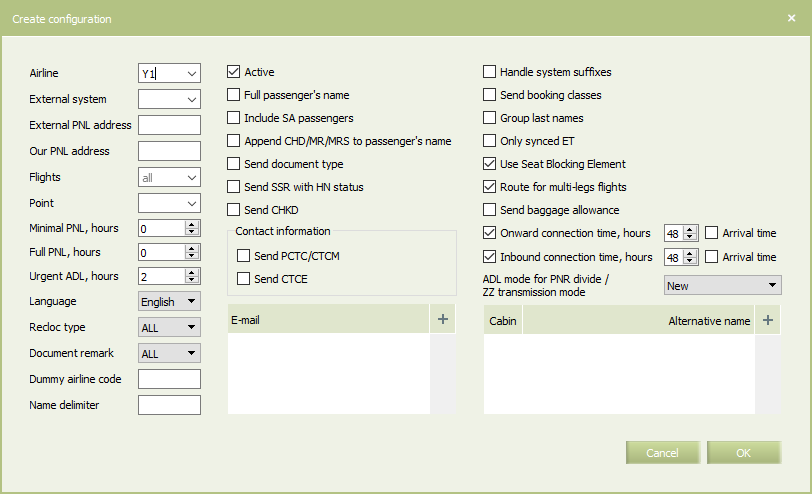PNL Settings
To set PNL configuration, proceed to the following main menu section: Business rules → Settings → PNL configuration. It contains the setting list for PNL/ADL outgoing telegrams.
To search for the stored configurations, use the following parameters:
- Airline — airline code
- External system — external system name
- Address — external system address
- Flight — flight number
- Point — departure point
- Active — configuration status.
After clicking Search, the configuration list will be presented.
By clicking Columns in the screen top right corner, it is possible to specify the displayed column list.
| The section's entries are available for editing only for users with the appropiate access rights. Without these rights, users can only view the entries. |
To edit the selected entry, use one of the following ways:
- Click Actions → Edit in the section's menu.
- Use the Edit command from the entry context menu by the right-click.
- Open the entry for viewing and click on the Edit link.
To create new configuration, click Create in the screen top right corner.
The following fields are presented in the Create configuration window:
- Airline — airline code.
- External system — external system list for the specified departure point. If the list is empty then check the availability of the implemented configuration in the Business rules - Settings → External systems section, the DCS tab. This section is set by the system provider. If there is no implemented configuration then contact
 support@amber.aero.
support@amber.aero. - External PNL address — DCS system address (telegram receiver).
- Our PNL address — Inventory system address (telegram sender).
- Flights — flight number. It is possible to specify one flight, flight list/range/group. The parameter is optional.
- Point — departure point. The parameter is mandatory.
- Language — PNL/ADL list generation language.
- Recloc type — INV/DISTR: inventory or distribution order number in PNL/ADL.
- Doc remark — ALL/PSPT/DOCS/FOID: document type for sending by PNL/ADL.
- Dummy airline — carrier code used for telegram generation. The field is not specified by default and the current airline code is used. The value format is 2-3 characters.
- Name delimiter — divider character used for full name generation. The value format is free.
- Minimal PNL, hours — time (in hours) before departure to send numeric PNL.
- Full PNL, hours — time (in hours) before departure to send PNL with passenger lists.
- Urgent ADL, hours — time (in hours) before departure to turn off the ADL sending cumulative method and to send ADL right after every order change (by default, it is equal to the flight check-in time – 2h).
The following flag may be set:
- Active — configuration is on.
- Include phones (R/PCTC) — send contact information (the format is
.R/PCTC). - Full passenger name — specify full passenger data (name, patronimic name, and surname).
- Include SA passengers — send passenger data with the SA segment status.
- Append CHD/MR/MRS to passenger's name — add the passenger name prefixes: “MR/MRS/CHD”.
- Send document type — send the document reference in the
./R OTHS HK1 DOCSformat. - Send SSR with HN status — include into PNL the following SSR in the “On Request” status:
- extra seats:
EXST,CBBG,STCR. - seat request:
RQST,SEAT,NSSA,NSSB,NSSR,NSST,NSSW,SMSA,SMSB,SMSR,SMST,SMSW,GPST. - children:
INF.
- extra seats:
- Send CHKD — if the mark is set, the following information from the DCS block is added to PNL:
- registration ID of the passenger (Boarding Pass Number);
- to .R / SEAT the actual seat number, to which the boarding pass is issued (the seat number is taken not from the SSR element in PNR (if it is in it) but from the DCS information);
- the format of the SSR CHKD element corresponds to PSCRM33 as of clause 2.12.6.10 or PSCRM 37 of clause 2.12.6.11.
- Contact information — Contact information - sending the contact details of the passenger. If none of the values is selected, PCTC REFUSED is sent. A contact that is not bound to any of the passengers personally will be sent as a РСТС contact for each passenger in PNR. Possible values:
- Send PCTC/CTCM — mobile phones are sent as CTCM, other phones as PCTC;
- Send CTCE — e-mail addresses are sent;
- Handle system suffixes — if the flight is delayed due to day change and the flight number receives the system suffix when this flag is on then PNL/ADL lists will be sent with the old flight parameters (flight number and date will be as before the delay). If the flag is off then after the delay (if the PNL is already sent), the
ADL DELwill be sent and PNL/ADL will be sent to the new flight number/date. - Send booking classes — if the flag is on then lists will be sent to PNL by booking classes, if not – then by service classes.
- Group last names — group passengers by surnames.
- Only synced Et — if the flag is on then only synchronized tickets (confirmed for the sync by ET server) will be sent in PNL/ADL lists.
- Use seat blocking element — if the flag is on then information on additional seats
CBBG,STCR,EXSTis transmitted in PNL/ADL as Seat Blocking element (ZZ-element), in the flag is off — then it is transmitted as Name Element. - Route for multi-legs flights is used for the cases when the Block Space agreement is set on the route parts, but not on the whole route:
- If the mark is set, then full route data is sent in PNL/ADL.
- If the mark is not set, then only data on flight legs included in the BS agreement is sent in PNL/ADL.
- Legs with traffic restriction (
I,A,Z) are excluded.
- Send baggage allowance is used to send the baggage allowance data in the
CKINSSR to DCS. It is off by default. To implement this feature, a carrier should consult the Commercial Department of Amber. - Onward/Inbound connection time (hours) — connecting segment sending in PNL/ADL telegrams:
- If the mark is set, then in PNL/ADL lists information about connecting segments is included (
.I(2,3…)/ or.О(2,3….)). Only information about segments within specified time interval (up to 24 hours by default) related to time of port, to which message is sent are included. If the connection exceeds 24 hours, then segment data sending is regulated by the time setting of 24-48 hours. - If the mark is not set, then such information is not included in PNL/ADL.
- For codeshare flights these elements contain flight operator RBD (fare class position). If it is not known (e.g., if no Class mapping is set by the marketing carrier for BlockSpace agreement), then marketing carrier RBD is sent.
- If the mark is set, then in PNL/ADL lists information about connecting segments is included (
- Arrival time — if the mark is set, then arrival time of continuation segment is formed each time when in PNR is stated such option. If the mark is not set, then arrival time of continuation segment is formed only if a flight arrives on a date other than departure date.
- ADL mode for PNR divide / ZZ transmission mode, values:
New,Old:- It regulates ADL generation during PNR split. For the old mode, only data of passengers that moved to new PNR is sent to the DEL section. For the new mode, the data of all passengers of the modified PNR is sent to the DEL section.
- It also regulates the ZZ element transfer. When PNL is generated, disregarding the parameter value, the ZZ element is sent in the list end by class. When ADL is generated and the value is
Old, the ZZ element is sent only in the list end of the ADD section. For the new mode, the ZZ element is sent in both sections (DEL and ADD) of a passenger data. - Also the NoNames (unnamed groups) transfer is managed. The value defines the NoNames transfer both for ADL and PNL. For the old mode, the data of unnamed groups is not sent. For the new mode, this data is sent in PNL/ADL.
In the bottom right part, there are fields to specify e-mails used for passenger list sending (for manual processing and sending to the check-in system).
See also:
- General Carrier Settings
- Service List Configuration
- APIS Configuration
- PAL/CAL: Lists of Passengers with Reduced Mobility
- Special Services Settings
- Booking Access Configuration
- Minimum Connection Time
